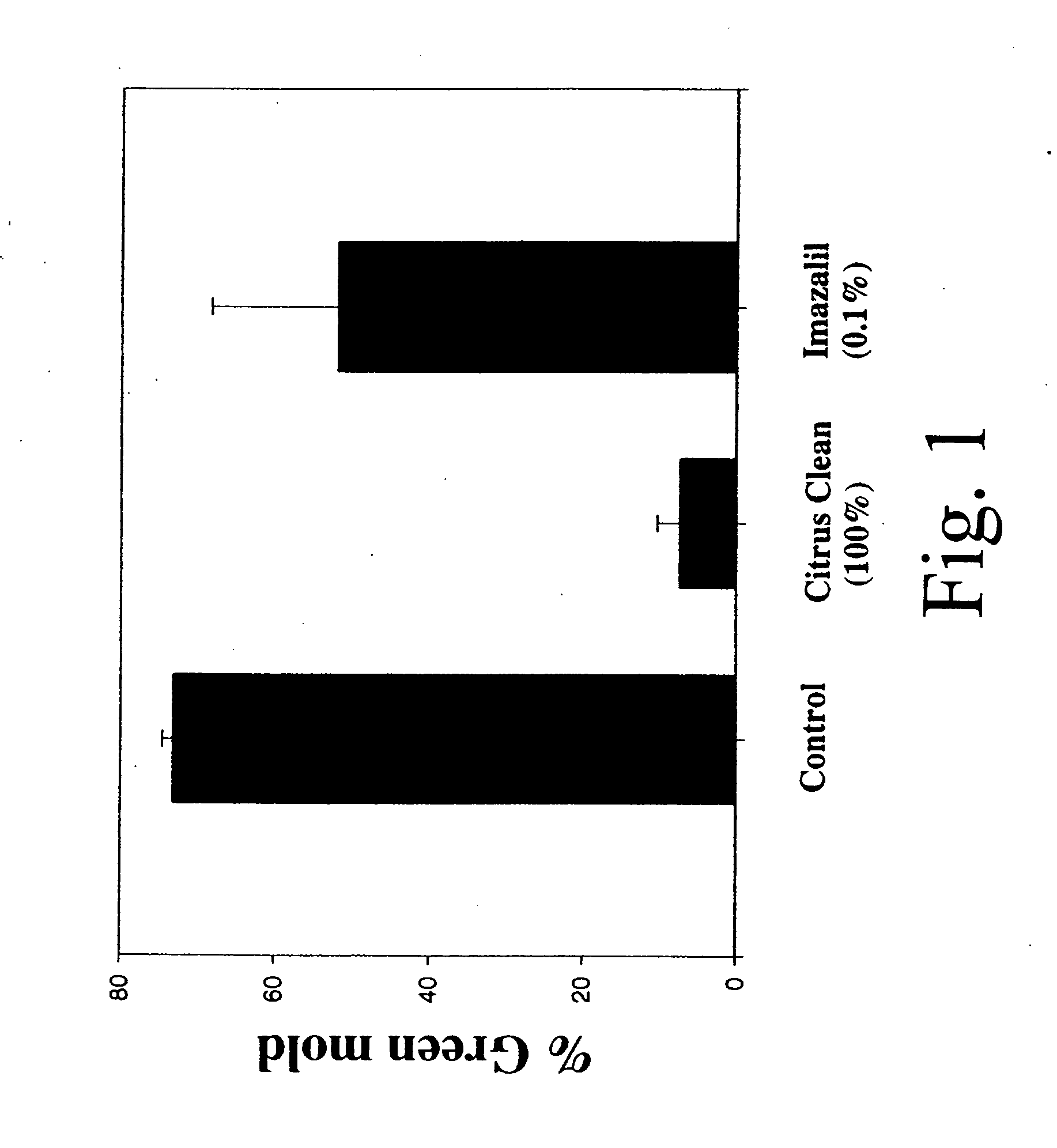Produce-treatment composition and method for treatment of fresh produce
a technology for fresh produce and composition, applied in the direction of biocide, plant/algae/fungi/lichens, peptide/protein ingredients, etc., can solve the problems of food spoilage, affecting the palatability of vegetables and fruits, affecting nutritional value, odor and aesthetic appearance,
- Summary
- Abstract
- Description
- Claims
- Application Information
AI Technical Summary
Benefits of technology
Problems solved by technology
Method used
Image
Examples
examples
[0056] Examples of produce-treatment biocides and methods of making the same will now be described in detail. It should be understood that the following compositions and methods are exemplary, but not exhaustive.
[0057] A dry enzyme blend having the composition set forth in Table 1 was hydrolyzed in distilled water to provide a solution of 10 weight percent enzyme blend in water.
TABLE 1EnzymeType DerivedSourceUnits (gram−1)CellulaseFungalTrichoderma5,000cu / gramCellulaseFungalAspergillus niger4,000cu / gramAmylaseFungalAspergillus oryzae20,000skb / gramProteaseFungalAspergillus oryzae40,000hut / gramLipaseFungalRhizopus oryzae3,000fip / gramLipaseYeastCandida cylindracea3,000fip / gram
[0058] A produce-treatment composition according to an embodiment of the invention was then prepared to have the formulation set forth in Table 2 below.
TABLE 2PhaseIngredientFunctionpbwRange (+ / −)Initial Temperature 40-45° C.1Polysorbate-20Nonionic surfactant24.002.001Polysorbate-80 / Tween80Nonionic surfactant...
examples 1-16
[0060] Cultures of the microorganisms Pseudomonas aeruginosa (ATCC No. 9027, Quality Technologies, Inc.), Escherichia coli (ATCC No. 8739, Quality Technologies, Inc.), Enterobacter cloacae (ATCC No. 13047, Quality Technologies, Inc.), Staphylococcus aureus (ATCC No. 6538, Quality Technologies, Inc.), Aspergillus niger (ATCC No. 16404, Quality Technologies, Inc), Aspergillus flavus (ATCC No. 26946, ATCC), Aspergillus parasiticus (ATTC No. 26863, ATCC), Penicillium species (in-house), Penicillium citrinum (ATCC No. 32006, ATTC), Klebsiella pneumoniae (ATCC No. 13882, Quality Technologies, Inc.), Salmonella typhimurium (ATCC No. 14028, Quality Technologies, Inc.), Streptococcus anginosus (ATCC No. 33397, Quality Technologies, Inc.), Rhizopus stolonifer (ATCC No. 14037, Quality Technologies, Inc.), and Penicillium digitatum were maintained as stock cultures from which working inocula were prepared. The viable microorganisms used were not more than five passages removed from the original...
examples 17-32
[0087] Cultures of the microorganisms Aspergillus niger (ATCC No. 16404, Quality Technologies, Inc), Penicillium species (in-house), and Penicillium digitatum (in house), Pseudomonas aeruginosa (ATCC No. 9027, Quality Technologies, Inc.), and Diplodia natalemsis (in house) were maintained as stock cultures from which working inocula were prepared. The viable microorganisms used were not more than five passages removed from the original stock culture, wherein one passage is defined as the transfer of organisms from an established culture to fresh medium. Plate preparation, inoculum and kill rate data collection were performed in accordance with ASTM E2315.03. All plate dilutions were performed in duplicate.
[0088] A. Preparation of Inoculum:
[0089] 1. Inoculate the surface of a suitable volume of solid agar medium from a recently grown stock culture of each of the microorganisms. Incubate the bacterial cultures at 35° C.±2° C. for 4-6 days.
[0090] 2. Determine the number of viable mi...
PUM
| Property | Measurement | Unit |
|---|---|---|
| weight percent | aaaaa | aaaaa |
| weight percent | aaaaa | aaaaa |
| temperatures | aaaaa | aaaaa |
Abstract
Description
Claims
Application Information
 Login to View More
Login to View More - R&D
- Intellectual Property
- Life Sciences
- Materials
- Tech Scout
- Unparalleled Data Quality
- Higher Quality Content
- 60% Fewer Hallucinations
Browse by: Latest US Patents, China's latest patents, Technical Efficacy Thesaurus, Application Domain, Technology Topic, Popular Technical Reports.
© 2025 PatSnap. All rights reserved.Legal|Privacy policy|Modern Slavery Act Transparency Statement|Sitemap|About US| Contact US: help@patsnap.com



